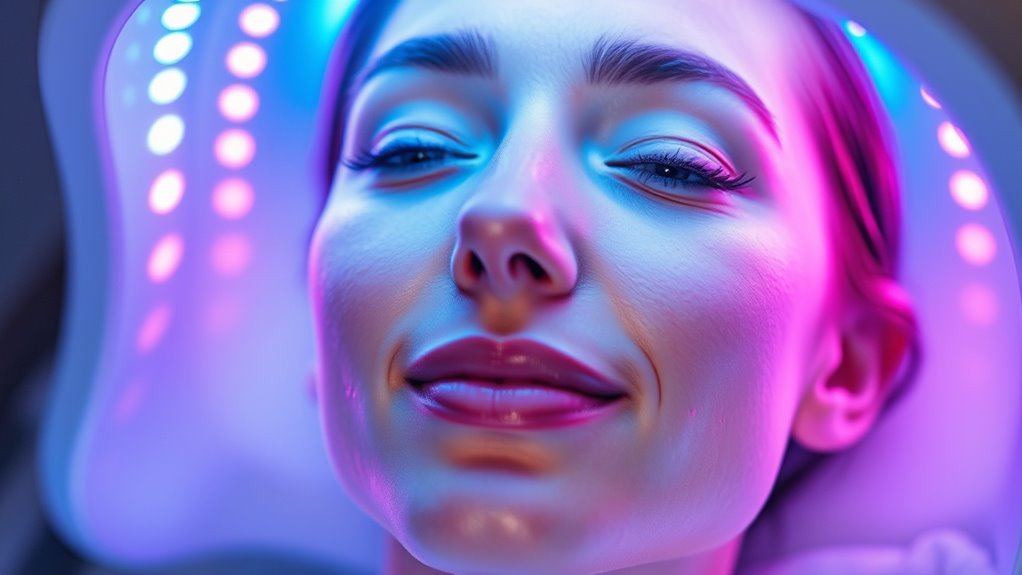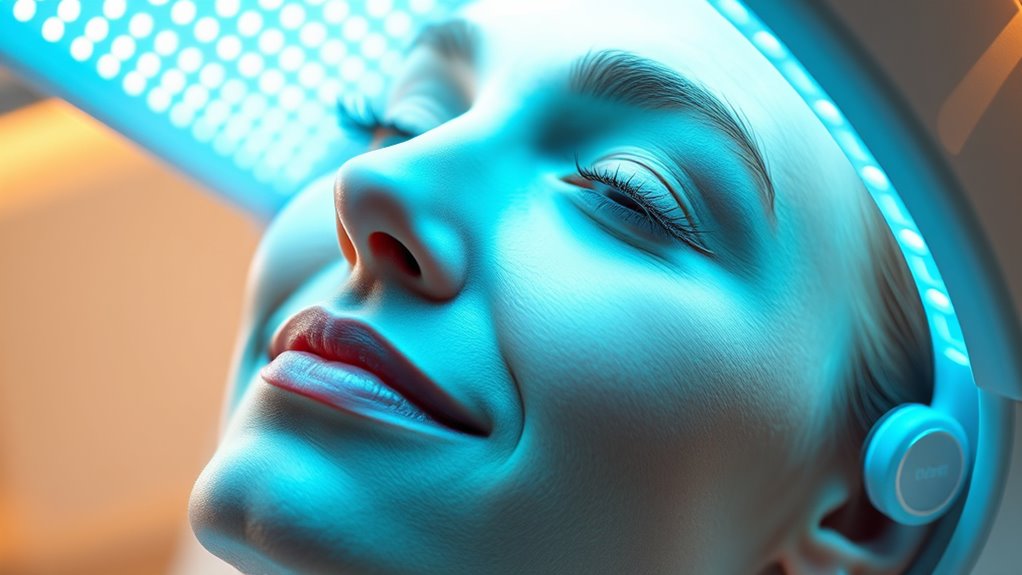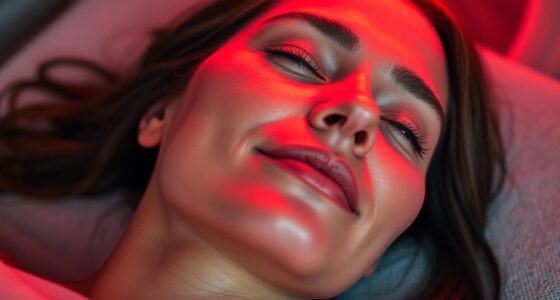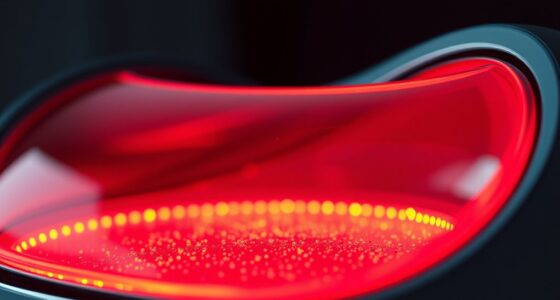Light therapy can support collagen production by penetrating deep into your skin and activating fibroblast cells, which are responsible for making collagen. Scientific studies show that red and near-infrared light improve skin elasticity, reduce fine lines, and enhance overall texture. It’s a safe, non-invasive option that encourages your skin’s natural healing processes. To discover how these therapies work and what results you might expect, keep exploring the promising research behind light therapy and collagen.
Key Takeaways
- Red and near-infrared light penetrate deep skin layers, stimulating fibroblasts to boost collagen production.
- Clinical studies report improved skin texture and reduced wrinkles following light therapy treatments.
- Light therapy activates the skin’s natural healing processes, enhancing collagen synthesis and cellular repair.
- Effectiveness depends on device quality, treatment frequency, and individual skin conditions.
- Generally safe and non-invasive, light therapy offers a scientifically supported method to support collagen growth.

Light therapy has gained popularity as a non-invasive treatment that can boost your skin’s health, particularly by stimulating collagen production. Collagen is essential for maintaining your skin’s elasticity, firmness, and youthful appearance. As you age, collagen levels decline naturally, leading to sagging, wrinkles, and dullness. Many people turn to light therapy as a way to counteract these signs of aging without resorting to invasive procedures. But does the science support its effectiveness? Current research suggests that certain types of light therapy, especially red and near-infrared light, can indeed promote collagen synthesis in your skin. These wavelengths penetrate deep into the dermal layers, where collagen fibers reside, stimulating the cells responsible for collagen production, called fibroblasts. When these cells are activated, they produce more collagen, which can help improve skin texture, reduce fine lines, and restore a more youthful glow.
Studies have shown promising results, with many participants experiencing noticeable improvements after a series of treatments. In clinical trials, subjects treated with red light therapy often report smoother skin and fewer wrinkles. The therapy appears to encourage your skin’s natural healing process, boosting not just collagen but also blood circulation and cellular repair. These combined effects contribute to healthier, more resilient skin. Additionally, wavelengths used in light therapy are critical for ensuring effective penetration and stimulation of skin cells. However, it’s important to recognize that individual results can vary based on factors like age, skin condition, and treatment frequency. While some may see significant changes after a few sessions, others might require ongoing maintenance to sustain the benefits.
Research also indicates that light therapy is safe when used correctly, with minimal side effects. Unlike invasive procedures, it doesn’t involve needles or chemicals, making it appealing for those seeking a gentle approach. That said, for ideal results, consistent treatments are necessary, often combined with a good skincare routine that includes sun protection, hydration, and antioxidants. It’s worth noting that not all light therapy devices are created equal. Professional-grade equipment used in clinics tends to deliver more effective wavelengths and energy levels than at-home devices. Still, many users find that with proper guidance, home treatments can be beneficial, especially for maintenance.
Frequently Asked Questions
How Quickly Can I Expect Visible Results From Light Therapy?
You might notice visible results from light therapy in as little as a few sessions, typically within 2 to 4 weeks. Consistency is key, so follow your treatment schedule diligently. Some people see improvements sooner, especially with targeted areas. Keep in mind, individual results vary depending on skin type, condition, and the severity of concerns. Patience and regular sessions will help you achieve the best possible outcomes.
Are There Any Side Effects Associated With Long-Term Light Therapy Use?
Long-term light therapy is generally safe, but you might experience minor side effects like skin irritation, redness, or dryness if you overuse it. Some people may develop eye strain or headaches if not used properly. To minimize risks, follow your device’s instructions, take breaks, and use eye protection. If you notice persistent discomfort or unusual symptoms, consult a healthcare professional to guarantee safe and effective treatment.
Can Light Therapy Replace Other Collagen-Boosting Treatments?
You can’t fully replace other collagen-boosting treatments with light therapy alone, but it’s a helpful addition. Studies show that light therapy can increase collagen production by up to 40%, complementing treatments like retinoids and fillers. Combining therapies often yields better results, so while light therapy is effective, using it alongside traditional options offers the best chance for youthful, firm skin.
Is Light Therapy Safe for All Skin Types and Ages?
Light therapy is generally safe for all skin types and ages when administered properly. You should follow recommended guidelines and consult a dermatologist, especially if you have sensitive skin or medical conditions. Mild side effects like redness or irritation may occur, but serious risks are rare. Always guarantee the device is FDA-approved or used by trained professionals to maximize safety and effectiveness for your specific skin needs.
How Often Should I Undergo Light Therapy Sessions for Optimal Collagen Support?
You should aim for 2 to 3 light therapy sessions per week for ideal collagen support. Consistency is key, so sticking to this schedule allows your skin to benefit most. Avoid overdoing it, as too many treatments can cause irritation. Follow your provider’s advice, and remember that results take time—typically several weeks—so patience and regular sessions are essential for seeing improvements in your collagen levels.
Conclusion
Just as the myth of Icarus warns us about overreaching, so too should we approach light therapy with balanced expectations. While some research suggests it can support collagen production, it’s not a magic fix—more like a guide on your journey to healthier skin. Embrace it wisely, knowing that like the steady sun’s rays, consistent, moderate use can help you shine. After all, true radiance comes from harmony, not haste.









